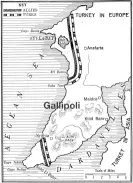Anzac Day
|

|
|
Share This Page
|
|
|
|
|
|
|
Follow This Site

|
 |
|
|
|
|

|
Every April 25, in Australia and New Zealand, people celebrate ANZAC Day, a very special holiday that commemorates the bravery of Aussies and Kiwis during the World War I battle at Gallipoli, in Turkey.
On April 25, 1915, thousands of young Australians and Kiwis landed on the shores of the Gallipoli Peninsula, a stronghold of the Ottoman Empire, some of which we now call Turkey. The Ottomans were on one side of World War I, along with Germany and Austria-Hungary; all three together were called the Central Powers. On the other side were Great Britain, France, Russia, and the United States. Soldiers from other countries also fought in the war, and this included Australia and New Zealand.
 The story of Gallipoli is a tragic one. Gallipoli was a peninsula that had strategic importance. The Allies (Britain, France, Russia, and the U.S.) wanted to take control of the Dardanelles Strait, in order to be able to strike at Istanbul, the capital of the Ottoman Empire. Capturing the Gallipoli Peninsula was a steppingstone on the way to control of the Dardanelles and, ultimately, of the Ottoman Empire. The Allies decided that the newly recruited Aussie and Kiwi troops would lead the charge on Gallipoli.
The story of Gallipoli is a tragic one. Gallipoli was a peninsula that had strategic importance. The Allies (Britain, France, Russia, and the U.S.) wanted to take control of the Dardanelles Strait, in order to be able to strike at Istanbul, the capital of the Ottoman Empire. Capturing the Gallipoli Peninsula was a steppingstone on the way to control of the Dardanelles and, ultimately, of the Ottoman Empire. The Allies decided that the newly recruited Aussie and Kiwi troops would lead the charge on Gallipoli.
The ANZAC (Australian and New Zealand Army Corps) troops went ashore and right into the teeth of a very well fortified position, defended by Turks with machine guns. The ANZACs had landed at the wrong place. The intended target was a flat beach, from where they could set up camp and strike inland. Instead, they landed on a small beach that ended in steep cliffs, on top of which were Turk after Turk, determined to defend their homeland with their bullets and their lives.
Undeterred after several intervals of withering fire, the ANZACs dug in—literally. They dug trenches and settled in for a series of charges and retreats, just like what was going on elsewhere during the war.
As with other unsuccessful invasions, the Gallipoli offensive eventually ended in a retreat, eight months later. In all, more than 8,000 ANZAC soldiers died. The rest were shipped back to Egypt, from where they were sent to Europe and Africa for the next three years, until the war was over.
The idea of celebrating ANZAC Day began almost immediately, with an observance that same month, back home. The remaining years of the war saw yearly remembrances, followed by a Public Holiday beginning in 1921 and continuing to this day. As with other holidays, ANZAC Day was used as a protest vehicle in the 1960s and 1970s. Today, however, it is primarily a solemn reminder of the sufferings and sacrifices of war.
|